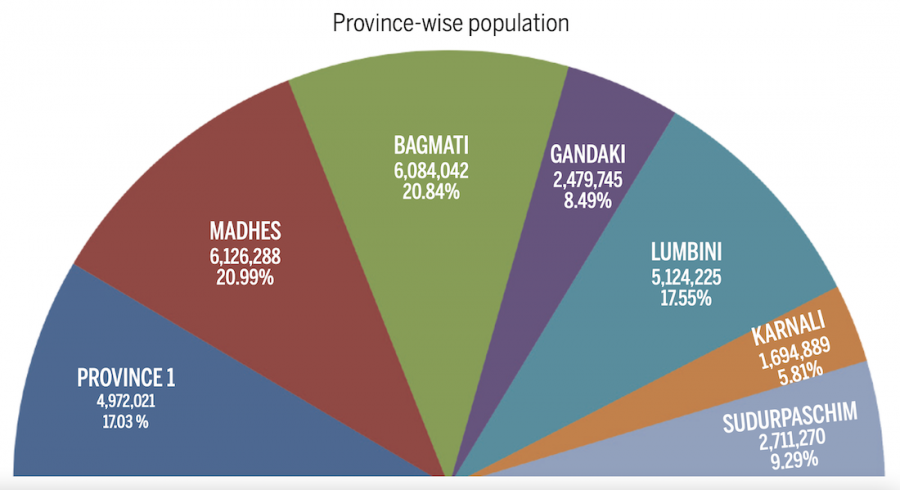
Bhojpur has been facing a monkey menace for the last few years as people are deserting the rural areas in search of better lives in urban centres and other districts with better amenities.
“Monkey terror has grown in most parts of the district because swathes of farmlands abandoned by their owners who have moved to cities or towns are regrowing into forests,” said Sudan Kirati, a member of parliament from the district. “With fewer people and less cultivated land, monkey menace has become uncontrollable.”
Bhojpur is one of the districts witnessing largest drops in population.
According to the preliminary report of the national census 2021, the population of the district saw an annual negative growth of 1.32 over the past decade–since the last census 2011–and the fourth highest drop after Ramechhap, Khotang and Manang over the period.
Bhojpur’s population decreased to 158,991 in 2021 from 182,459 population in 2011, according to the bureau. There are as many as 32 districts which saw population drops over the last one decade.
All the districts witnessing population declines are from either hilly or mountain regions of the country. None of the districts in the Tarai saw a drop in population.
As a result, Tarai region witnessed a rise in population while the other two regions saw a drop over the last one decade. Geographically, Nepal is divided into hilly, mountain and Tarai regions. According to the bureau, 53.66 percent of the country’s population now lives in the Tarai, up from 50.27 percent 10 years ago.
According to the bureau’s data, 40.27 percent of the national population lives in the hilly region, down from 43.01 percent in 2011, and 6.09 percent of the population lives in the mountain region, down from 6.73 percent 10 years ago.
Lawmakers from the districts seeing population declines say ongoing outmigration from the hills and mountains in search of better opportunities, education, health and employment among other things is responsible for the phenomenon.
They said while the reduced fertility rate of women has also contributed to the decline in population growth, outmigration is mainly responsible.
“We failed to provide better health, education and agricultural services in the rural areas and this prompted many people to migrate to urban areas and other districts,” said lawmaker Kirati, who is from the ruling CPN (Maoist Centre). “Many people have temporarily migrated to Dharan and Itahari for the sole purpose of giving better education to their children.”
He stressed particularly the need for ensuring quality education in the district to prevent outmigration.
Shyam Kumar Shrestha, a lawmaker from Ramechhap district, thinks the proximity of his home district to the Kathmandu Valley is one of the reasons that has spurred outmigration.
The district saw the largest annual declines in population over the last 10 years as the population decreased from 202,646 in 2011 to 170,620 in 2021. The population saw an annual negative growth of 1.65 percent, according to the top statistics agency.
“On one hand, the fertility rate itself has gone down because people don’t want to give birth to more children nowadays,” said Shrestha. On the other hand, people either educated or uneducated, have moved to urban centres in the district or Kathmandu valley in search of better education, employment and better lives.”
He said that despite increased road connectivity and electricity access in the district, outmigration has not stopped. “But if we are able to promote entrepreneurship along with improved access to electricity and physical infrastructure, the trend can be reduced,” said Shrestha.
A number of hydropower projects are being implemented in the district including Sunkoshi II and these are expected to boost the income of the locals in the next few years. “But a rise in income may also encourage many people to buy property in urban centres including the Capital,” Shrestha said.
Some lawmakers have questioned the very counting process. Bishal Bhattarai, a lawmaker from Khotong representing the CPN-UML, said thousands of people from his district who are living in other districts were not counted in the census.
“I have received many such complaints from people from my district,” he said.
According to him, a large number of people from Khotang have settled temporarily in Dharan, Biratnagar, Gaighat and Katmandu among other places for giving good education to their children and for employment purposes and they might have been excluded from the census data.
Khotang saw a drop in population by 1.56 percent annually over the last decade, the second largest drop rate after Ramechhap. Khotang district had a population of 206,312 in 2011 which dropped to 175,340 in 2011, according to the bureau.
Bhattarai claimed that on the one hand many people were not counted and on the other there is the lure of better amenities in the urban centres in the lowlands and these two factors have contributed to the population decline in Khotang.
According to experts, the growing migration to the Tarai from the hills has widened the demographic imbalance both in the hills and the mountains, and this could invite more socio-economic problems, according to officials and analysts.
Hari Roka, a political economist, told the Post last week that the massive migration from hills to the Tarai may invite confrontation between the migrant populations and the local residents of the region.
“The growing migration to the Tarai will also lead to a loss of farmlands in the region, which is known as the country’s bread basket. This could impact the country’s food security,” he said.
“We have already seen confrontations between political groups representing the Madhesi people and those of hills orgin such as the confrontation in the past between Madhesi parties and the Chure Bhawar Rastriya Ekata Party representing the people of hills origin,” he said.
Lawmaker Bhattarai said migration ultimately hits agricultural productivity of the country. “When human settlements occupy the fertile Tarai lands and farmlands in the hills and mountains remain fallow, this will hit food production,” he said. Bhattarai’s concern is genuine as government figures suggest the import of food and agricultural products has been increasing constantly.
According to a study conducted by the National Planning Commission, the country imported agricultural goods worth over Rs200 billion in the fiscal year 2019-20, which could be produced within the country. Most agricultural goods came from India, according to the study titled ‘Status of Export and Import of Agriculture Goods.’
Meanwhile, on the monkey menace in Bhojpur, lawmaker Kirati said he has already requested the home minister, forests minister and home secretary to find ways to tackle the problem.
Lawmakers also stressed the need for concrete measures to retain population in the hills through better service delivery and promotion of development and economic activities.
“One solution could be developing integrated settlements with all urban amenities in the hill districts,” said Bhattarai. “And this can be done only with support from the federal government in planning and implementation.”













